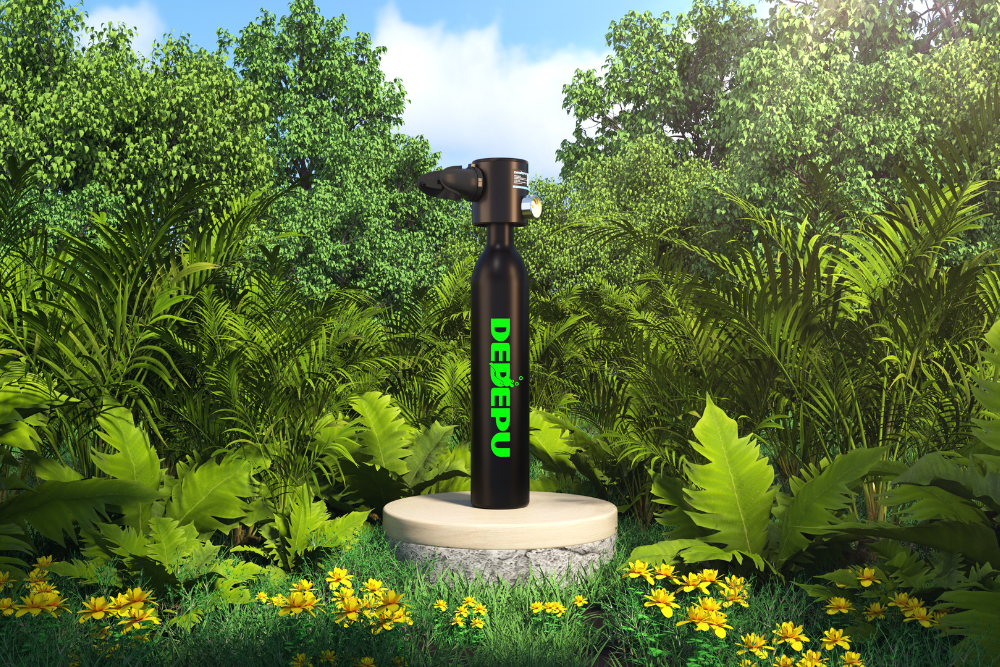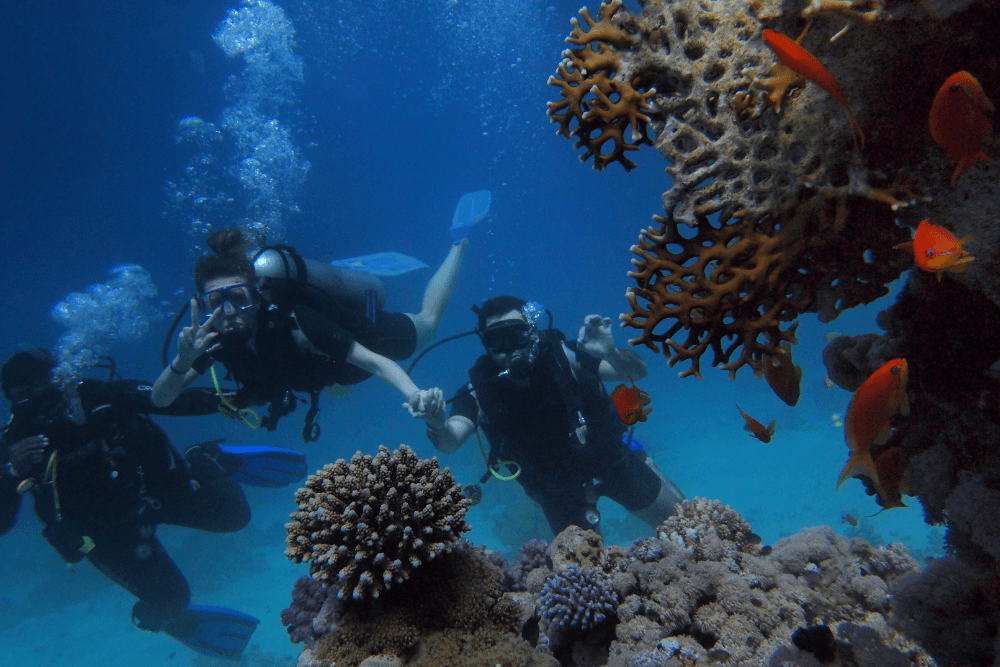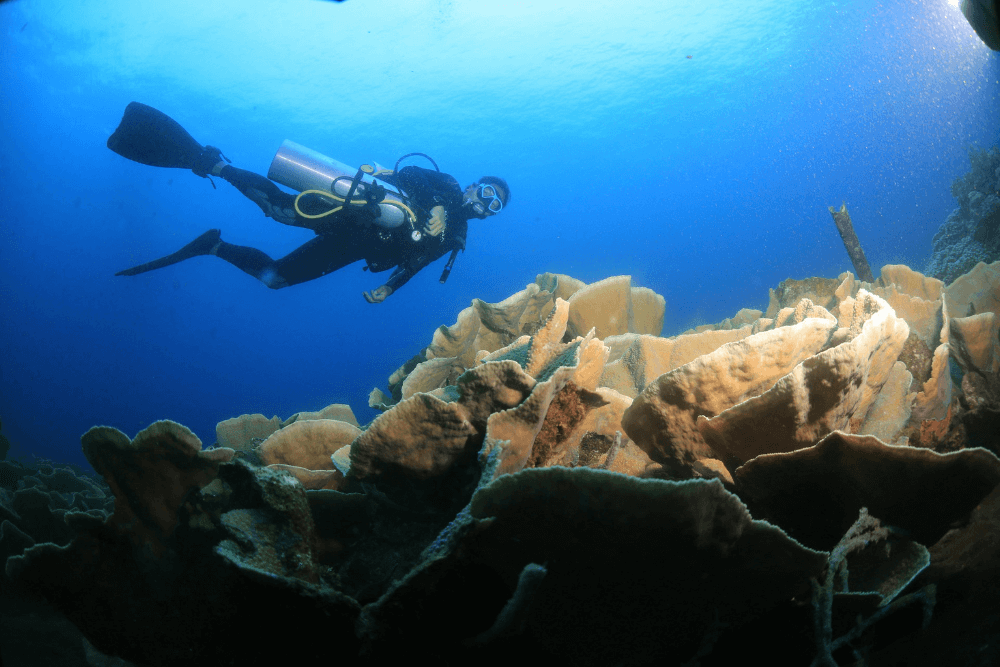A standard 80-cubic-foot (11.1L) aluminum tank holds about 3,000 psi (207 bar) when full, but how can you check? First, read the pressure gauge—if it shows below 500 psi (34 bar), the tank is nearly empty. Next, listen for air by slightly opening the valve; a faint hiss means air remains. Comparing weight helps too—a full tank weighs about 5 lbs (2.3 kg) more than an empty one. Testing the regulator with a slow breath confirms airflow. Check the last fill date—unused tanks lose pressure over time.
Read the Pressure Gauge
A standard aluminum 80-cubic-foot (11.1L) tank holds 3,000 psi (207 bar) when full. If the needle drops below 500 psi (34 bar), you’re running critically low—time to surface. Gauges have a ±5% margin of error, so always double-check if readings seem off. Cold water can temporarily drop pressure by 100-200 psi (7-14 bar), but it normalizes as the tank warms. If your gauge shows 0 psi, the tank is definitely empty—don’t risk it.
Read It Correctly
Check before every dive—even if the tank was filled yesterday. Slow leaks can drain 50-100 psi (3.5-7 bar) per day.
Compare with a known full tank—if yours reads 2,800 psi (193 bar) instead of 3,000 psi (207 bar), it’s 93% full, not empty.
Watch for gauge damage—a stuck needle or fogged glass means replace it immediately (cost: 30-80).
When to Trust (and Distrust) the Gauge
Trust it if:
The reading is steady (not flickering).
It matches another gauge within ±100 psi (7 bar).
Distrust it if:
The needle jumps erratically (possible internal damage).
It shows 3,000 psi (207 bar) on an old tank (likely a stuck sensor).
Pro Tip
If your dive computer also displays tank pressure, cross-check both. A 10% difference between devices means one needs calibration
Listen for Air
A fully pressurized 80-cuft (11.1L) tank at 3,000 psi (207 bar) releases air at ~25 L/min when the valve is cracked open—you'll hear a sharp, steady hiss. If the sound weakens to <5 L/min or stops entirely, the tank is below 200 psi (14 bar) and unsafe for diving. Even a tiny leak of 1 psi/min (0.07 bar/min) can drain a tank over hours, so always test before gearing up.
Positioning
Place your ear within 6 inches (15 cm) of the valve for optimal sound detection
Remove hoods/headgear that may muffle sound (reduces audible range by 20-30%)
Valve Operation
Turn the knob 10-15 degrees counterclockwise - this creates an opening of 0.04-0.06 inches (1-1.5 mm)
The ideal hissing frequency ranges between 2,000-4,000 Hz (most audible to human ear)
Duration Test
A full tank should maintain audible airflow for:
3-5 seconds with valve opened 10%
8-12 seconds with valve opened 5%
Interpreting the Sounds
| Sound Characteristic | Air Pressure Estimate | Dive Time Remaining* |
|---|---|---|
| Loud, sharp hiss (>75 dB) | 2,000-3,000 psi | 45-60 min |
| Moderate hiss (65-75 dB) | 1,000-2,000 psi | 20-45 min |
| Weak hiss (50-65 dB) | 500-1,000 psi | 10-20 min |
| Intermittent puffing | 200-500 psi | <10 min |
| No sound | <200 psi | Empty |
Based on average consumption of 0.5 cuft/min at 30 ft (9 m)
Troubleshooting Common Issues
No Sound But Gauge Shows Pressure
80% probability: Blocked valve or regulator
Try gently tapping the first stage with a 5-10 oz (150-300g) rubber mallet
Inconsistent Hissing
Could indicate:
Moisture contamination (reduces flow by 15-20%)
Valve wear (typically occurs after 500+ openings)
High-Pitched Whistle
Suggests:
Extremely high pressure (>3,300 psi/228 bar)
Orifice restriction (reduces flow capacity by 30-40%)
Advanced Techniques
Smartphone Audio Analysis
Use apps like Spectroid (Android) or Decibel X (iOS) to:
Measure sound pressure level (accuracy ±1.5 dB)
Analyze frequency spectrum for irregularities
Thermal Detection
A full tank's valve will be 3-5°F (1.5-2.8°C) cooler than ambient due to gas expansion
Bubble Test for Tiny Leaks
Apply soapy water to valve connection
1 bubble every 2 seconds = ~5 psi/min leak
Constant stream = >20 psi/min leak (needs immediate service)
Maintenance Tips
Clean valve threads every 10-15 fills with brass brush
Replace O-rings after 100 uses or when hardened
Have valves professionally inspected every 2 years or 300 fills
Pro Tip
For the most accurate results:
Test at consistent ambient temperatures (60-80°F/15-27°C ideal)
Perform test 3 times and average the results
Compare against a known full tank's hiss profile

Compare the Weight
A standard aluminum AL80 tank weighs 31.4 lbs (14.2 kg) when empty but jumps to 38.2 lbs (17.3 kg) when filled to 3,000 psi (207 bar). That's 6.8 lbs (3.1 kg) of pure air weight – enough to clearly feel the difference when lifting. Steel tanks show even greater variation: a HP100 goes from 32.1 lbs (14.6 kg) empty to 41.5 lbs (18.8 kg) full – a 9.4 lbs (4.3 kg) increase.
The most accurate way requires a digital scale with ±0.1 lb (50g) precision.
New AL80 tank (empty): 31.4 ±0.3 lbs
After 1 year of use: 31.5-31.7 lbs (oxide buildup)
After hydrostatic test: 31.3-31.4 lbs (internal polishing removes some material)
Tank Weight by Pressure Level
| Pressure (psi) | Weight Added | Total Weight | Buoyancy in Seawater |
|---|---|---|---|
| 500 | +1.1 lbs | 32.5 lbs | -0.5 lbs |
| 1,500 | +3.4 lbs | 34.8 lbs | -1.2 lbs |
| 2,500 | +5.7 lbs | 37.1 lbs | -1.6 lbs |
| 3,000 | +6.8 lbs | 38.2 lbs | -1.8 lbs |
Practical Weight Checking Methods
Two-Hand Lift Test
Hold tank at 45° angle with both hands
Full tank requires 12-15 lbs (5.4-6.8 kg) more lifting force
Perceived weight difference equals carrying 3 full soda cans
Knee Balance Method
Rest tank bottom on knee while standing
Full tank creates 2-3x more downward pressure
Empty: Mild pressure (like 10 lb dumbbell)
Full: Significant pressure (like 25 lb weight)
Scale-Free Estimation
Use common objects for reference:
6.8 lbs ≈ 3 liters of water
6.8 lbs ≈ 2.5 bricks
6.8 lbs ≈ 7 standard dive weights
Environmental Factors Affecting Weight
Temperature:
Cold water (50°F/10°C): +0.3-0.5% weight
Warm water (86°F/30°C): -0.2-0.4% weight
Altitude:
At 5,000 ft (1,500m): -1.2% weight
At sea level: Standard weight
Maintenance Impact on Weight
New valve: +0.1-0.2 lbs
Corroded interior: +0.3-0.8 lbs after 5 years
After hydrotest polishing: -0.05-0.1 lbs
When Weight Checks Are Most Useful
After visual inspection fails
When gauge readings seem questionable
For tanks stored longer than 6 months
When preparing multiple tanks for a dive trip
Pro Tip
Mark your tank's empty weight on the boot with permanent marker. Then note:
Single line = empty (31.4 lbs)
Two lines = half full (+3.4 lbs)
Three lines = full (+6.8 lbs)
Test the Regulator
At 3,000 psi (207 bar), a standard second stage delivers air at 1.4 inches water column (350 Pa) inhalation effort. But when pressure falls to 1,000 psi (69 bar), breathing resistance increases 18-22% – you'll notice the difference immediately. Below 500 psi (34 bar), most regulators require 2-3x more effort, signaling it's time to surface. This test works even when gauges fail, giving you a direct physiological warning.
Breathing Effort by Pressure Level
| Tank Pressure | Inhalation Effort | Equivalent Physical Sensation |
|---|---|---|
| 3,000 psi | 1.4" H₂O | Breathing through a straw |
| 2,000 psi | 1.7" H₂O (+21%) | Thick milkshake straw |
| 1,000 psi | 2.1" H₂O (+50%) | Breathing through a clogged filter |
| 500 psi | 3.5" H₂O (+150%) | Trying to inhale through a wet T-shirt |
Step-by-Step Breathing Test
Pre-Test Preparation
Purge regulator for 2 seconds to clear water
Ensure mouthpiece is dry (moisture adds 5-10% resistance)
Test Procedure
Take 3 normal breaths (1.5-2L volume each)
Then attempt 1 deep breath (3-4L volume)
Note effort required on scale of 1-5:
1 = Normal
3 = Noticeable effort
5 = Extremely difficult
Result Interpretation
If deep breath feels 20% harder than normal → ~1,500 psi remaining
If normal breaths require conscious effort → ~800 psi
If you can't complete deep breath → <300 psi
Regulator Performance Factors
Age: After 500 dives or 5 years, spring tension decreases 8-12%
Maintenance: Serviced regulators perform 15% better at low pressure
Water Temp: Cold water increases effort 3-5% due to denser air
Common Mistakes
Testing with fast breaths (misses gradual pressure drops)
Ignoring first breath after purging (most accurate indicator)
Not comparing against known full tank reference
Pro Tip
For advanced monitoring:
Use a pressure transducer (measures exact breathing effort)
Record your normal breathing pattern with full tank
Compare real-time breathing to baseline during dive

Check the Last Fill Date
Industry data shows a standard 80 cuft aluminum tank loses 50-75 psi (3.4-5.2 bar) per month through natural leakage. That means a tank filled to 3,000 psi (207 bar) six months ago could now sit at 2,550-2,700 psi (176-186 bar) - still showing pressure but potentially 15% depleted before your dive. Steel tanks fare better, losing just 30-50 psi (2.1-3.4 bar) monthly due to their thicker walls.
Pressure Loss Timeline
[New Fill: 3,000 psi]
│
├─ 1 month later: 2,925-2,950 psi (97.5-98.3% remaining)
│
├─ 3 months later: 2,775-2,850 psi (92.5-95% remaining)
│
├─ 6 months later: 2,550-2,700 psi (85-90% remaining)
│
└─ 12 months later: 2,100-2,400 psi (70-80% remaining)
How to Read Fill Dates Correctly
Professional fills use month/year stamps (e.g., "7/24" = July 2024)
DIY markers often show day/month/year (e.g., "15.07.24")
No date? Assume it's 12+ months old if stored
Tank Aging Factors
Valve Type
K-valves lose 60 psi/month
DIN valves lose 40 psi/month
O-Ring Age
New: <50 psi/month loss
2+ years old: 75+ psi/month loss
Storage Position
Vertical: 50 psi/month loss
Horizontal: 65 psi/month loss
When to Definitely Reject a Tank
Last fill >18 months ago (even if pressure looks OK)
Stored near heat sources (>90°F/32°C accelerates leakage)
Shows corrosion around valve threads
Missing hydrotest sticker (>5 years since last test)
Pro Maintenance Tip
Track your tanks with a simple spreadsheet:
| Tank ID | Last Fill | Current PSI | Months Since Fill | PSI Loss/Month |
|---|---|---|---|---|
| ALX-107 | 15.04.24 | 2,850 | 3 | 50 |
| STL-209 | 01.03.24 | 2,920 | 4 | 20 |
Quick Field Test
If you find an old tank:
Note current pressure
Wait 24 hours
Check pressure again
10 psi drop = significant leak
Remember: A tank showing pressure isn't always dive-ready. Always combine this check with other methods before entering the water




Laisser un commentaire
Tous les commentaires sont modérés avant d'être publiés.
Ce site est protégé par hCaptcha, et la Politique de confidentialité et les Conditions de service de hCaptcha s’appliquent.